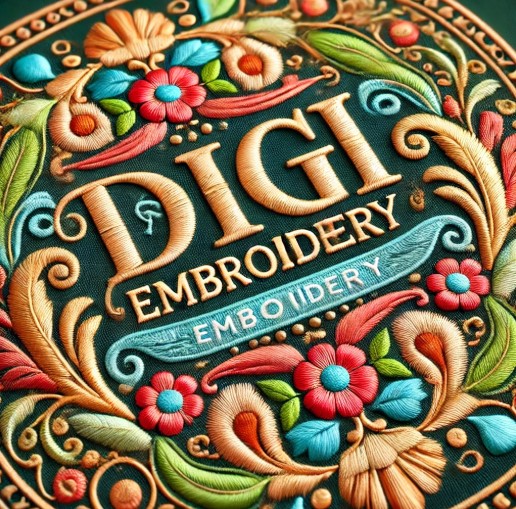1. Hand Embroidery: A Timeless Classic
Hand embroidery is one of the oldest and most respected techniques in the world of fashion. It involves the manual stitching of intricate designs using a needle and thread. Although time-consuming, this method adds a personal and artistic touch to garments, accessories, and even corporate branding materials.
In the realm of personalized fashion, hand embroidery provides endless opportunities to create one-of-a-kind pieces. From floral designs to abstract patterns, hand embroidery allows for a deep level of customization. For branding, this technique delivers a sense of craftsmanship and attention to detail that appeals to businesses aiming to highlight tradition and quality in their brand identity.
2. Machine Embroidery: Efficiency Meets Precision
While hand embroidery offers artistic flair, machine embroidery has revolutionized the process by providing both speed and precision. This technique utilizes computer-aided designs (CAD) and embroidery machines to produce consistent, high-quality results in large quantities. Machine embroidery is ideal for creating personalized logos, patches, and other branding materials.
Many companies prefer machine embroidery for uniforms, branded merchandise, and promotional items because of its efficiency and cost-effectiveness. The accuracy of machine embroidery also ensures that brand logos remain consistent across all products, strengthening brand recognition.
3. Satin Stitch Embroidery: Bold and Beautiful
The satin stitch is one of the most popular embroidery techniques, known for its bold, smooth, and shiny appearance. This technique is ideal for creating lettering, logos, and large areas of solid color in both fashion and branding. Satin stitch works particularly well on hats, jackets, and shirts, making it a go-to choice for custom embroidery projects.
For fashion designers, satin stitch offers the opportunity to make a statement. Whether it’s a name, a word, or a logo, satin stitch provides high visibility and a professional finish, helping individuals and brands stand out in style.

4. Appliqué Embroidery: Multi-Dimensional Appeal
Appliqué embroidery is another widely-used technique that adds texture and dimension to fabric. It involves stitching cut pieces of fabric onto a base material to form patterns, logos, or designs. This technique is often seen in sports team logos, fashion pieces, and corporate uniforms.
For branding, appliqué embroidery offers a distinctive way to showcase logos, especially on larger surfaces like jackets and bags. The raised and textured nature of appliqué makes it an eye-catching choice that’s both durable and aesthetically pleasing.
5. 3D Puff Embroidery: Standing Out, Literally
As the name suggests, 3D puff embroidery gives designs a three-dimensional appearance by using foam under the embroidery thread. This creates a raised effect that adds depth and visual interest. Puff embroidery is particularly popular for hats, caps, and outerwear, where bold and eye-catching designs are desired.
For brands looking to make their logos “pop,” 3D puff embroidery is a top choice. It adds a premium feel to any piece of clothing or accessory, making it a favorite among fashion-forward businesses.
6. Monogram Embroidery: Personalization at its Finest
Monogram embroidery has been a classic symbol of elegance and personalization for centuries. This technique involves stitching initials or letters onto garments, accessories, and household items such as towels or linens. Monograms are a popular choice for custom fashion, wedding gifts, and branded merchandise.
For businesses, monogram embroidery allows companies to add a personal touch to their products, whether it’s a branded tote bag, a custom shirt, or a luxury gift item. This technique helps businesses create a strong emotional connection with customers, elevating their brand image.
7. Chenille Embroidery: A Textured Touch
Chenille embroidery, often associated with varsity jackets and sportswear, is a plush and textured technique that creates a soft, raised design. This method involves using yarn rather than traditional thread, resulting in a fuzzy and tactile finish.
Fashion designers and businesses use chenille embroidery for its unique texture and nostalgic appeal. It’s ideal for adding dimension to logos and symbols, offering a tactile experience that draws attention to the design.
8. Chain Stitch Embroidery: An Antique Charm with Modern Applications
Chain stitch embroidery is another ancient technique that has made a comeback in both personalized fashion and branding. It uses a looped stitch that resembles chains and is ideal for adding detailed and flowing designs. Chain stitch works well for creating bold, continuous lines, making it perfect for large, sweeping logos or intricate patterns on apparel.
Chain stitch has an antique charm, but when used in modern applications, it adds a unique texture that can enhance both fashion garments and branded products.
9. Embossed Embroidery: A Subtle Elegance
Embossed embroidery is a technique where designs are sewn into the fabric in a way that creates a subtle, raised texture. This technique is perfect for logos and designs that require a more understated and elegant look.
In the world of fashion and branding, embossed embroidery is favored by luxury brands and high-end designers who want to maintain a refined and polished aesthetic. It works well on premium fabrics and adds a touch of class to personalized items.
Why Embroidery Remains Popular in Fashion and Branding
The enduring popularity of embroidery in both fashion and branding lies in its ability to fuse creativity with craftsmanship. Unlike printed designs, embroidered logos and designs have a tactile, multi-dimensional quality that adds a sense of value and uniqueness.
In the age of personalization, consumers and businesses alike are gravitating towards products that allow them to express their individuality. Whether it’s a one-of-a-kind fashion piece or a custom branded item, embroidery offers endless possibilities for customization.
Embroidery also offers durability that is unmatched by other methods like screen printing or heat transfer. The stitching process ensures that designs remain intact even after repeated use and washing, making it an excellent investment for businesses and individuals alike.
Share this:
- Click to share on Twitter (Opens in new window)
- Click to share on LinkedIn (Opens in new window)
- Click to share on Tumblr (Opens in new window)
- Click to share on Facebook (Opens in new window)
- Click to share on Pinterest (Opens in new window)
- Click to share on WhatsApp (Opens in new window)
- Click to share on Reddit (Opens in new window)

